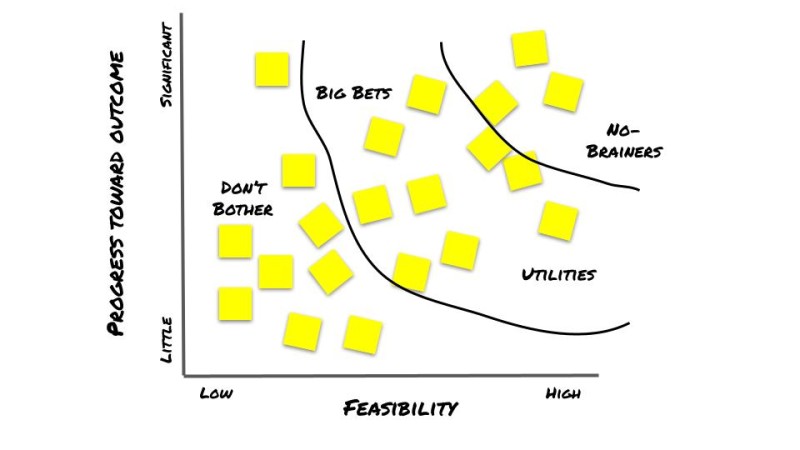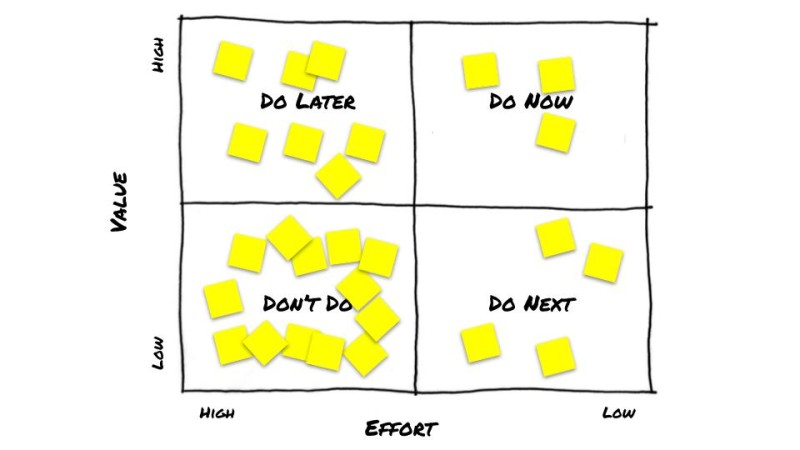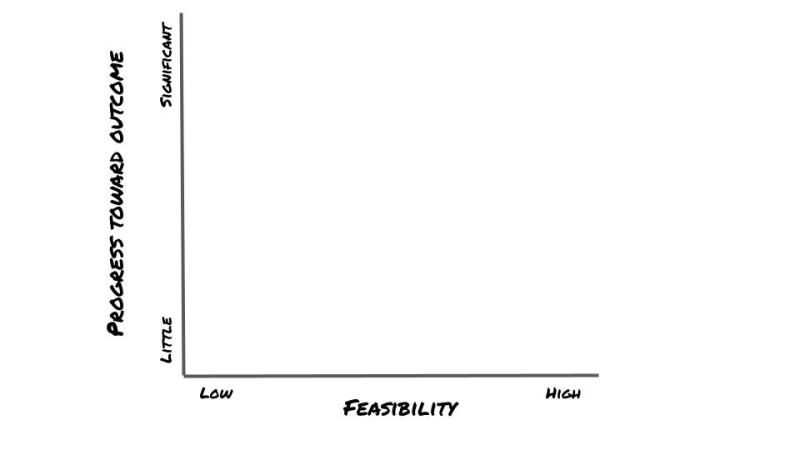
You’ve identified the problem to solve and you’ve managed to keep your users focused on the problem and not suggesting solutions.
Your team has done a great job of coming up with tons of great ideas for how to address that problem.
Now you need to pick which option to try first. This is important so that you don’t try to deliver too many options if one option will solve the problem.
In this case prioritization is all about picking the solution to work on first so that your team can focus and so that you don’t spend a lot of effort working on solutions you may not need.
“So”, you may be asking yourself, “how can I pick the option to focus on first?” It’s helpful to have some criteria you can use to evaluate the possible solutions and pick the one to start with.
The prioritization grid, and a related technique the prioritization matrix provide one set of criteria. Let’s take a look at what these techniques are and how you can use them to narrow down the options you have to pick from and ultimately pick which option to work on first.

What is a prioritization grid
A prioritization grid is a technique you can use to guide conversations about a set of ideas. In the case described above, those ideas are options for solving a specific problem.
The general idea behind the prioritization grid is to place your ideas on the grid in relation to a couple of criteria, then use the relative location of the ideas to determine what to do with them.
The criteria most often used is some sense of value on the y-axis and some sense of effort on the x-axis. If you want to reinforce an outcome focus and you want to make the criteria a bit more specific, you may choose to have the y-axis reflect progress toward outcome and the x-axis reflect feasibility.
An alternative form - the prioritization matrix
If you’re more of a fan of 2x2 matrices (and c’mon, who isn’t) you can replace the more free flowing prioritization grid with the prioritization matrix. It generally gets you to the same result, but with a bit more guidance.

You can, of course, use the same criteria on the matrix as described for the grid above. The guidance in each quadrant should generally stay the same.
The rest of this article describes how to use the prioritization grid, but most of the steps directly translate to using the matrix.
Why use a prioritization grid
There are a few reasons to use a prioritization grid. There’s the benefit to prioritization in general, then there’s the benefit you get from using the prioritization grid (or matrix) to help you prioritize.
The main reason you prioritize at all is so that you can stay focused on one thing at a time in order to get it done. For all the bluster about efficiency - being able to do things quickly - the best way to ensure that you get things done is to focus on the right things to the exclusion of everything else.
That’s where the prioritization grid comes into the picture. It provides a framework that helps you decide which options to focus on. You base your prioritization decisions on specific criteria, and you have a way to structure your conversations so you can incorporate different perspectives.
The prioritization grid allows you to create many different ideas, and then evaluate those ideas through the lenses of progress toward an outcome and feasibility to identify the option you want to try first. It helps you to split the activities of creation and evaluation which your brain can’t do at the same time anyway.
When to use a prioritization grid
The prioritization grid is most helpful when you have a collection of ideas that you’ve generated and you need to pick which one to do first. You can use the prioritization grid when you start work solving a new problem to pick from different options for a solution.
Your team may also use the prioritization grid to evaluate the backlog items that you have to choose from in order to deliver your solution. In fact, you can use the prioritization grid (or prioritization matrix for that matter) to narrow down any collection of ideas according to a couple of criteria.
How to use a prioritization grid
The following description of how to use a prioritization grid to guide a collaborative product prioritization discussion was inspired by this piece from IBM’s Enterprise Design Thinking toolkit and this technique for collaboratively discussing risks. You’d be amazed what you can do with a good grid and some real (or virtual) post it notes.
The steps in this approach are:
Identify ideas
Setup
Evaluate Ideas
Focus conversations
These instructions work if everyone is in the same room standing at a whiteboard or are all virtual. If you are in a virtual setting, substitute the physical whiteboard for a tool such as Miro.
Identify Ideas
If you want your prioritization effort to be successful, start off with a batch of quality items to prioritize. There’s a variety of ways you can create those quality items, but all of those ways tend to follow a few basic rules.
Involve the right people when creating ideas. Who are the right people? Those who contribute a different and meaningful perspective on the problem and possible solutions. This is why you want diversity on your team so that your team is able to look at things from a variety of perspectives.
Make sure everyone participates. By virtue of having a wide range of perspectives creating ideas, you’ll inevitably have a mix of extraverts and introverts. You want to make sure that everyone feels comfortable providing ideas.
One way to do that is to give everyone a chance to provide ideas. First individually, and then discussing with the group. If you’re all in the same room, sticky notes. If you’re remote, provide everyone the opportunity to type in ideas. Start by collecting individual ideas, and then discussing them as a group.
Remember, and reinforce, that there are no bad ideas - allow everyone’s ideas to get out so that they influence others. You want to take the approach of yes, and. Instead of dismissing ideas that others suggest, take the opportunity to build upon them.
And finally, remember quality over quantity. Yes, you’d like to have several options to pick from, but you also want to make sure that you have good choices to pick from. One way to do this is to provide some guardrails for your team when they are crafting ideas. The best guardrail - what problem are you trying to solve. If an idea doesn’t solve the problem, forget about it.
Setup
Once you have a collection of ideas, it’s time to explore those ideas and narrow the many down to the few.
This is where the prioritization grid comes into play.
As a starting point, create (in reality or virtually) a display with a pair of axises. The y axis reflects some sense of value. The x axis reflects some sense of effort. As discussed earlier, we’re going to customize the axises to a product management line of thinking which results in the following:

The X axis is feasibility (low to high). The Y axis is progress toward outcomes ranging from little to significant. Little progress toward outcome corresponds to low value. Significant progress toward outcome corresponds to high value.
Evaluate Ideas
So you have your ideas, and you have your display for organizing those ideas. The next thing you need to do is get all of your ideas onto the display. Here’s how to do that.

Gather your ideas together and put them in a pile (if using sticky notes) or put them in a list (if working virtually).
Ask for a volunteer to start. That volunteer takes the first item from the pile/list and places it on the grid based on it’s progress toward the outcome and feasibility.
The next volunteer has three options:
Place - put the next idea on the display relative to the first one
Move - change the position of an idea already on the display to another location on the board. If you choose this option you should explain why you’re moving the item.
Pass – you don’t want to place or move. This choice should really only be used when the number of ideas is getting low.
Repeat Step 3 until all the ideas have been placed on the display and everyone has passed.
Once all of the ideas have been placed and everyone has passed, give everyone a chance to look at the display and discuss everyone’s impression of the results.
Focus conversations
Once you have all of your ideas placed on the grid, it’s time to determine which ideas you’re going to focus on first. This is where the idea’s location on the grid becomes extremely important.
Sketch two lines across the grid radiating out from the upper left. Any items which end up in the upper right-hand section are labeled No-Brainers. Label the items in the center-right area Utilities and the center-top area Big Bets.
Label all the items to the left of the second line Don’t Bother.
The No-Brainers are the first items you’ll consider to work on, remembering to start with only one.
If you haven’t solved your problem and have tried all of the No-Brainers, you then need to pick from the Big Bets and Utilities, but you need to do some refinement on those items.
You’ll want to look for ways to make your Big Bets a bit more feasible, and you’ll want to revise utilities so that they provide more progress toward your outcome.
You can just ignore the Don’t Bother items - they won’t amount to anything.
Want to learn more about prioritization?
The prioritization grid is one way to help you evaluate your available options, but it’s certainly not the only way to make prioritization decisions, and it’s not appropriate for every situation.
If you’d like to learn about other techniques how you can use to make prioritization decisions, check out our ebook on Mastering Prioritization.

Kent McDonald

Read also





Prioritize with confidence

Experience the new way of doing product management



